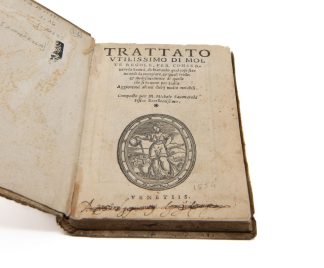SAVONAROLA, Giovanni Michele.
EATING, DRINKING AND COOKING
Trattato utilissimo di molte regole, per conservare la Sanità.
Venice, haer. G. Padovano, 1554.£2,750.00
8vo. ff. 84 ll. Italic letter. Woodcut printer’s device, full-page woodcut of the Crucifixion to title verso, decorated initials. A little toning, small tear along upper gutter of title, couple of small, very faint water stains to lower blank margins of first gathering. A very good copy in contemporary vellum over boards, ms title to spine (repaired to match), traces of c.1900 printed label to upper cover, C18 ms ‘in indice 1764 non vi è’ and two pasted paper slips from C19/20 catalogues to front pastedown, C18 ms ‘mautome’ to fly, crossed-out C17 ms ex-libris to title
A good copy of this important work on well-being and the preservation of health. Giovanni Michele Savonarola (1385-c.1461) was a physician in Ferrara, professor at Padua, and the author of popular medical books on pathology and obstetrics. First published in 1508, this is a little vernacular manual on the healthiest types and best methods of preparation and administration of food and drink. It is addressed to Savonarola’s patron, Borso, Duke of Modena, and seeks to provide guidance on what should be served, and how, during his meals and banquets. It is thus a detailed snapshot of Italian diet, and eating and cooking habits, c.1400. For each food or drink Savonarola provides general information on recipes (e.g., asparagus with oil, vinegar and cinnamon) and therapeutic virtues (based on Avicenna and Galen), as well as the downsides (e.g., just the smell of garlic may make some people feel immediately sick). The treatise begins with maize, with observations on how it was ground to make flour, proceeding to bread (of which Savonarola lists three kinds, according to the amount of bran in it), barley, spelt, rice and other cereals. It continues with herbs, vegetables and fruit – e.g., mint (used boiled in water by women to treat breast inflammation), radicchio, asparagus (diuretic), figs (if eaten excessively, they could cause death), oranges, apples, pistachios and truffle (especially liked by Savonarola’s patron). Meat, including fowls and quadrupeds, and fish are treated together, followed by eggs and dairy. After a section on wine and water, the penultimate part is devoted to dressings and spices, e.g., honey (from bees or sugar cane), sugar (also the fine white type called ‘taberzet’), black pepper (‘expensive’), cinnamon, saffron (which makes people laugh without a reason, if served with wine), and salt (which makes all foods more pleasant). The last part is devoted to healthy habits, such as exercise and rest, and to common doubts such as whether one should drink before eating, whether lunch or supper should be the main meal, or what the best sleeping position is considered to be. An important and interesting work.
USTC 855320; EDIT16 47761; Durling 4076; Wellcome I, 5792; Simon 583 (ch.4 on vines, ch.11 on wine). Not in Heirs of Hippocrates, Osler, Bitting or Oberlé.In stock






